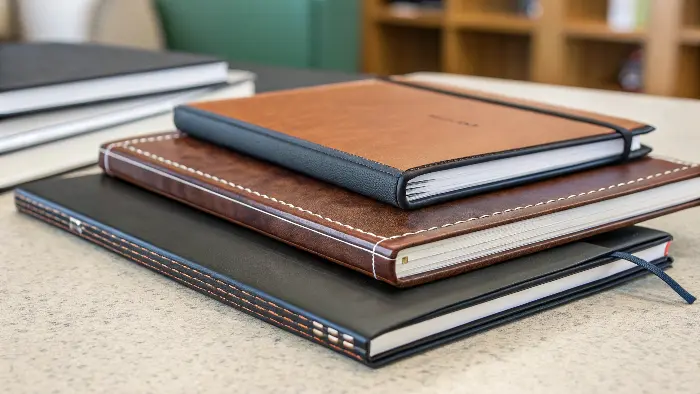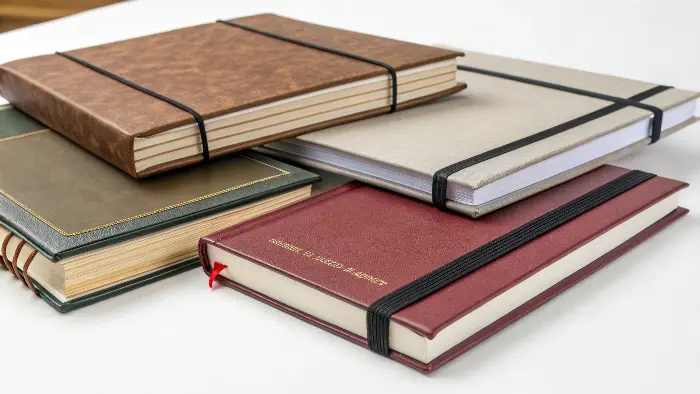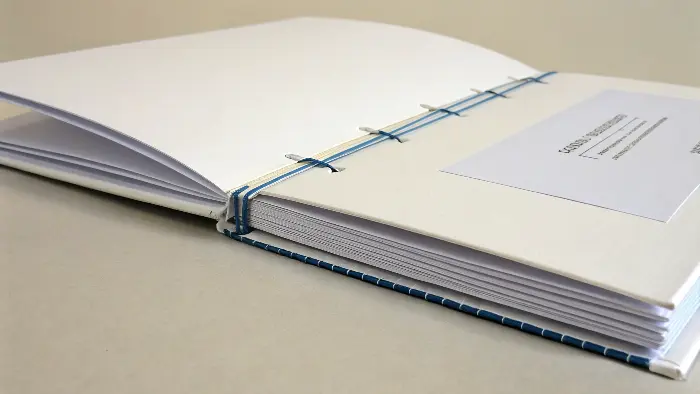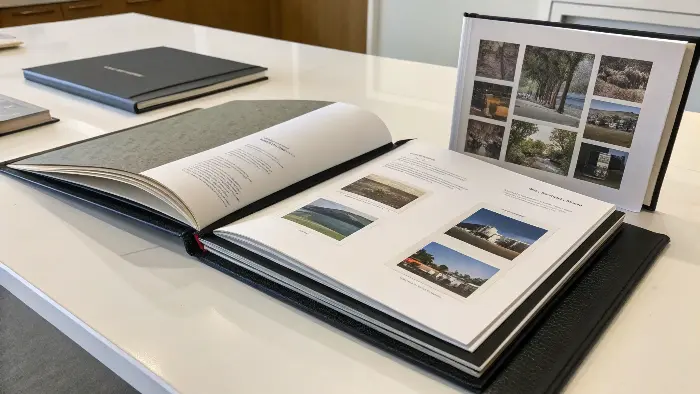Ever felt that sinking feeling when your beautifully designed corporate catalog starts falling apart after just a few uses? Or maybe it just doesn’t quite have that premium feel you were aiming for. It’s a common problem, and the solution often lies in something many overlook: the binding.
For corporate catalogs, the best binding really depends on your needs. Hardcover binding offers top-notch durability and a premium look, perfect for making a lasting impression. Perfect binding is great for thicker catalogs, giving a sleek, professional finish. And for thinner catalogs or when budget is key, saddle-stitching is a popular, cost-effective choice. It’s all about balancing looks, lifespan, and cost.

Choosing the right binding for your corporate catalog is a bigger deal than you might think. It’s not just about holding pages together; it’s about how your brand is perceived and how well your catalog stands up to handling. I’ve seen so many companies invest heavily in design and printing, only to skimp on the binding, and it really shows. You want something that not only looks good on day one but also stays looking good. So, let’s dive into what makes a binding suitable for your project, ensuring it’s both tough and presentable.
What Are the Main Types of Binding You Should Know?
Feeling a bit lost with all the binding jargon out there? You’ve got your catalog ready, but now you’re hit with terms like "saddle stitch," "perfect bound," "case bound," and you’re just trying to figure out what holds paper together best. It can be overwhelming!
The four main types of binding you’ll likely consider for catalogs are saddle stitch, perfect binding, spiral/Wire-O binding, and hardcover (or case) binding. Each has its own strengths, ideal uses, and cost implications, so understanding them helps you pick the perfect match for your project’s page count, budget, and desired impression.

Okay, let’s break these down a bit because knowing the basics here can save you a lot of headaches – and money! I remember when I first started dealing with print suppliers for Panoffices, I just nodded along, but now I know how crucial these distinctions are. It’s not just about picking one; it’s about picking the right one for your specific catalog. Think about how thick your catalog is, who will be using it, and what kind of vibe you want to give off. For instance, a quick, promotional booklet might be fine with a simple staple, but a high-end product showcase? That needs something more substantial. We’ll explore how these methods differ in terms of durability, appearance, and how they handle different numbers of pages. It’s all about making an informed choice.
Diving Deeper into Binding Options
Let’s get into the nitty-gritty of these common binding types. Understanding their characteristics will really help you decide.
| Binding Type | Description | Best For | Pros | Cons |
|---|---|---|---|---|
| Saddle Stitch | Pages are folded and stapled through the spine fold. | Thin booklets, magazines, brochures, small catalogs (typically under 64-80 pages). | Cost-effective, lays relatively flat, quick turnaround. | Not suitable for many pages, staples can look less premium. |
| Perfect Binding | Pages are glued together at the spine with a flexible adhesive, then covered. | Thicker catalogs, softcover books, journals, manuals. | Professional, printable square spine, durable for many pages. | Doesn’t lay completely flat, minimum page count needed (around 48+). |
| Spiral/Wire-O | Holes are punched along the spine, and a plastic coil or metal wire is inserted. | Notebooks, planners, reports, presentations, cookbooks, manuals. | Lays completely flat, can fold back on itself, various color options. | Pages can sometimes tear out, spine isn’t printable, can be bulkier. |
| Hardcover | Pages are sewn or glued into a "text block," then attached to rigid cover boards. | Premium books, yearbooks, high-end catalogs, portfolios. | Most durable, high perceived value, very professional appearance. | Most expensive, longer production time, heavier. |
I’ve seen clients choose saddle stitch for a quick event guide, and it was perfect – light, easy to distribute. But for our main Panoffices product catalog, which is quite substantial, perfect binding gives it that sleek, professional edge we need. And when we did a special anniversary edition, we even considered a short run of hardcover – talk about making an impression! The key is matching the binding to the catalog’s purpose and your brand’s image.
So, What’s Generally Considered the Best Book Binding Method?
You’re probably wondering if there’s one "king" of binding methods, right? It’s easy to get caught up thinking there must be a single best option when you’re trying to make your catalog look amazing and last. But the truth is, it’s not quite that simple.
There isn’t one single "best" book binding method overall because it heavily depends on the book’s purpose, page count, budget, and desired aesthetic. For ultimate durability and a premium feel, hardcover (case binding) is often considered top-tier. However, for many commercial catalogs, perfect binding offers an excellent balance of professionalism and cost-effectiveness for higher page counts.

Think about it – the "best" binding for a children’s board book (super durable, probably stitched and glued) is totally different from the "best" for a disposable weekly flyer (maybe just folded, no binding!). When we talk about corporate catalogs, we’re usually looking for a sweet spot. We want something that feels good in the hands, represents our brand well, and doesn’t fall apart if someone actually, you know, uses it. I’ve learned that "best" is subjective. It’s about what’s best for you and your project. Let’s explore what factors make a binding method "best" in different scenarios, especially for those important company catalogs.
Factors Defining the "Best" Binding for Your Catalog
When I say "best," what I really mean is "most suitable." For a corporate catalog, several factors come into play:
-
Page Count: This is a huge one.
- Low Page Count (e.g., 8-64 pages): Saddle stitch is often ideal. It’s economical and works well. I remember a small promotional booklet we did for a trade show; saddle stitch was perfect.
- Medium to High Page Count (e.g., 60-250+ pages): Perfect binding is your go-to. It handles the thickness well and gives you that nice, flat spine for printing a title. Our main Panoffices catalog uses this, and it looks great on a shelf.
- Very High Page Count / Archival Quality: Hardcover binding is the premium choice. It’s built to last and makes a statement. If you’re creating a flagship catalog that you want clients to keep for years, this is worth considering.
-
Durability Needed: How much handling will it get?
- A catalog for a trade show might only need to last a few days.
- A reference catalog on a buyer’s desk needs to withstand frequent use. Hardcover or a robust perfect bind is better here. I’ve seen cheap bindings give out, and it just looks unprofessional.
-
Desired Aesthetic & Brand Perception:
- Want a sleek, modern look? Perfect binding.
- Need something that screams luxury and longevity? Hardcover.
- Looking for functional and budget-friendly? Saddle stitch or even spiral if it needs to lay flat for note-taking. We once did a training manual with spiral binding so people could easily write in it – super practical!
-
Budget:
- Saddle stitch is generally the most cost-effective.
- Perfect binding is mid-range.
- Hardcover is the most expensive.
So, the "best" method is a balancing act. For most corporate catalogs, perfect binding often hits that sweet spot of quality, durability, and cost for a decent page count. But if your catalog is thin, saddle stitch is a smart choice. And if you want to go all out, hardcover is the way.
What Type of Binding Is Typically Used for Booklets?
Thinking about smaller publications, like informational booklets, event programs, or thin product guides? You might be wondering if they need the same heavy-duty binding as a massive catalog. It’s a good question because overdoing it can be a waste of money.
For booklets, saddle-stitching is the most common and cost-effective binding method. This involves folding sheets of paper and securing them with staples along the spine. It’s ideal for publications with a lower page count, typically up to around 64-80 pages, depending on paper thickness.

Booklets are often designed for quick information sharing or short-term use, so the binding needs to be practical and economical. I’ve produced countless little guides and promotional pieces for Panoffices using saddle stitch, and it’s almost always the right call. It’s quick to produce, keeps costs down, and the booklets lay relatively flat, which is great for readability. Of course, if your "booklet" starts getting quite thick, you might lean towards perfect binding, but for the true, slim booklet, saddle stitch reigns supreme. Let’s look a bit closer at why this is the go-to and when you might consider an alternative.
Why Saddle Stitch Shines for Booklets (And When It Doesn’t)
Saddle stitch is super popular for booklets for a few key reasons:
- Cost-Effectiveness: It’s generally the cheapest binding method because the process is simpler and uses less material. When you’re printing a lot of booklets, those savings add up. I remember getting quotes for a small product insert, and saddle stitch was significantly cheaper than any other option.
- Quick Turnaround: Because it’s a simpler process, printers can often produce saddle-stitched booklets faster. This is great if you’re on a tight deadline for an event.
- Lays Relatively Flat: Especially for thinner booklets, they open up nicely, making them easy to read and view spreads. This is a big plus for things like event programs or instruction manuals.
- Lightweight: Fewer materials mean a lighter end product, which can be good for postage costs if you’re mailing them.
However, saddle stitch isn’t a one-size-fits-all solution, even for booklets. The main limitation is page count. The "staples in the middle" approach has its limits.
- Too many pages: If you try to saddle stitch too many pages (the exact number depends on paper thickness, but generally over 64-80 pages is pushing it), the booklet won’t close properly. It will "creep" or "push out" at the edges and look bulky and unprofessional. I’ve seen this happen, and it’s not a good look.
- Durability for very heavy use: While fine for most booklet applications, if it’s something that will be handled extremely roughly or needs to last for years and years, you might consider a more robust (though more expensive) option, even if the page count is low.
For most things we call "booklets" – think product updates, small guides, event schedules – saddle stitch is the efficient, smart choice. It gets the job done well without breaking the bank.
And What’s the Best Binding for a Portfolio?
Alright, let’s switch gears to portfolios. If you’re a designer, artist, photographer, or even a company showcasing high-value projects, your portfolio is your ambassador. So, how it’s bound is super important, right? You want it to scream professionalism and quality.
For a portfolio, the best binding often prioritizes a lay-flat presentation and a high-quality aesthetic. Wire-O binding, high-quality perfect binding that can lay flatter, screw-post binding, or even custom hardcover options are excellent choices. The goal is to showcase your work beautifully and allow for easy viewing without spine interference.

When I think about portfolios, I think about making an impact. This isn’t just about holding pages; it’s about creating an experience. I’ve seen some stunning portfolios, and the binding always plays a key role. You don’t want a potential client or employer struggling with a book that won’t stay open or looks like it could fall apart. The binding needs to complement the quality of the work inside. It’s an investment in how you or your projects are perceived. So, let’s dig into what makes these options suitable for such an important presentation piece.
Making Your Portfolio Shine with the Right Binding
Choosing a binding for a portfolio is less about pure cost-saving and more about impact and functionality. Here’s why certain types work well:
-
Lay-Flat Capability: This is probably the most crucial feature. You want your spreads to be fully visible without the viewer having to hold the pages down.
- Wire-O or Spiral Binding: These are champions of laying flat and even folding back on themselves. Wire-O (metal) often looks more professional than plastic spiral for a portfolio. I’ve used Wire-O for internal presentation documents that needed to be easily referenced during meetings.
- Screw Post Binding: This offers a very sophisticated, customizable look. Pages are typically loose-leaf with holes punched, held together by screw posts. This also allows you to easily add or remove pages, which is a huge plus for a growing portfolio. It feels very bespoke.
- Lay-Flat Perfect Binding: Some printers offer special perfect binding techniques that allow the book to open much flatter than a standard perfect-bound book. This can give you the sleek spine of perfect binding with better viewing.
- Custom Hardcover with Special Construction: A well-made hardcover can be designed to lay relatively flat, especially if it’s Smyth-sewn (pages stitched in sections). This is the premium, archival choice.
-
Aesthetics and Professionalism:
- Hardcover: Offers a very high-end, durable, and impressive feel. A custom debossed or foil-stamped hardcover portfolio is a statement piece.
- High-Quality Materials: Regardless of the type, using quality cover stock, good paper, and a well-executed binding process is key. Even a Wire-O bound portfolio can look fantastic if the materials are top-notch.
-
Durability: Portfolios get handled, passed around. The binding needs to be robust. Wire-O is pretty sturdy. Screw posts are very strong. A well-made hardcover is built to last.
When I was putting together a showcase of Panoffices’ custom design capabilities for a major potential client, we opted for a custom, small-run hardcover portfolio with lay-flat pages. It was an investment, for sure, but the feedback was that it looked incredibly professional and really highlighted the quality of our work. For a portfolio, don’t skimp on the binding – it’s part of your first impression!
Conclusion
So, choosing the right binding for your corporate catalog, booklet, or portfolio really boils down to its purpose, page count, and the impression you want to make. From cost-effective saddle stitch for thin booklets to professional perfect binding for thicker catalogs, and premium hardcover for lasting impact, the right choice enhances your message.

